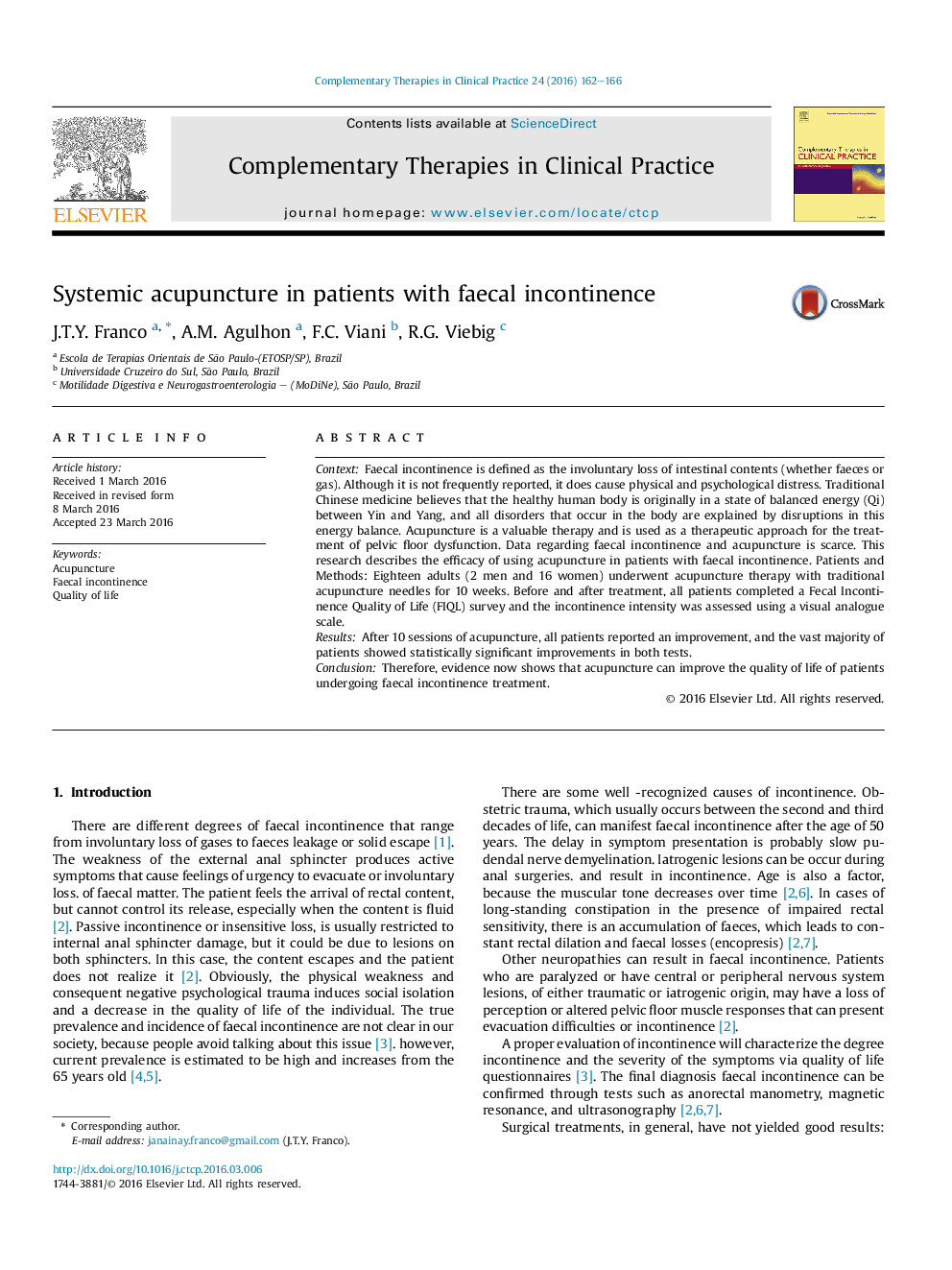| کد مقاله | کد نشریه | سال انتشار | مقاله انگلیسی | نسخه تمام متن |
|---|---|---|---|---|
| 2628339 | 1563190 | 2016 | 5 صفحه PDF | دانلود رایگان |
کلمات کلیدی
1.مقدمه
1.1 طب سوزنی و طب سنتی چینی
2.هدف
3. بیماران و روش ها
شکل 1 شبکه نقاط درمان بی اختیاری مدفوع . بدن انسان به وسیله طرح نشان داده شده است که نقاط انتخاب شده برای کار طب سوزنی در قسمت اعصاب و اندام پایین، سمت راست و چپ و مناطق پشت و شکمیLI 11 (Quchi) :، PC 6 (Neiguan)، ST 37 (Shangiuxu)، SP 9 (Yinlingquan)، BL 54 (Weizhong)، KI 7 (Fuliu)، CV 9 (Shuiefen)، CV 6 (Qihai)، CV 3 (Zhongji)، LV 13 (Zhangmen)، BL 23 ( Shenshu)، BL 25 (Dachangshu)، BL 32 (Ciliao)، LU 9 (Taiyuan)، TH 5 (Waiguan)، SP 6 (Sanyinjiao)، BL 67 (Zhiyin)، SP 2 (Dadu)، GB 41 (Linqi) . امتیازها بدون علامت گذاری سوزن ها برای هماهنگی قرار می گیرند. فلش بالا یک موقعیت را در تونینگ نشان می دهد و یک فلش پایین نشان دهنده موقعیت سوزن برای آرام سازی است.
3.1 داده ها و تجزیه و تحلیل آماری
4.نتایج
5. بحث
جدول1. داده های دموگرافیک و پرسشنامه VAS قبل و بعد از درمان
جدول2. نتایج حاصل از پرسشنامه FIQL برای قبل و بعد از درمان ارائه شده است.
6.نتیجه گیری
• Faecal incontinence is a worldwide challenge while there are no definitive treatments due to different etiologies.
• Acupuncture in essence is strongly indicated in the pelvic floor dysfunction rehabilitation.
• The data about acupuncture results in faecal incontinence is scarce.
• Excellent results were obtained after acupuncture needles application in 18 patients both in the quality of life score as in the severity of symptoms.
ContextFaecal incontinence is defined as the involuntary loss of intestinal contents (whether faeces or gas). Although it is not frequently reported, it does cause physical and psychological distress. Traditional Chinese medicine believes that the healthy human body is originally in a state of balanced energy (Qi) between Yin and Yang, and all disorders that occur in the body are explained by disruptions in this energy balance. Acupuncture is a valuable therapy and is used as a therapeutic approach for the treatment of pelvic floor dysfunction. Data regarding faecal incontinence and acupuncture is scarce. This research describes the efficacy of using acupuncture in patients with faecal incontinence. Patients and Methods: Eighteen adults (2 men and 16 women) underwent acupuncture therapy with traditional acupuncture needles for 10 weeks. Before and after treatment, all patients completed a Fecal Incontinence Quality of Life (FIQL) survey and the incontinence intensity was assessed using a visual analogue scale.ResultsAfter 10 sessions of acupuncture, all patients reported an improvement, and the vast majority of patients showed statistically significant improvements in both tests.ConclusionTherefore, evidence now shows that acupuncture can improve the quality of life of patients undergoing faecal incontinence treatment.
Journal: Complementary Therapies in Clinical Practice - Volume 24, August 2016, Pages 162–166
